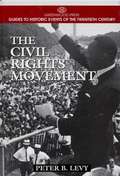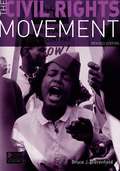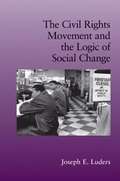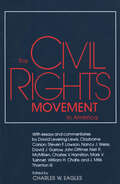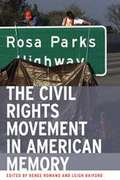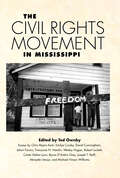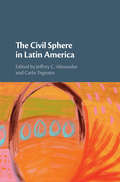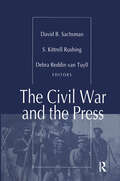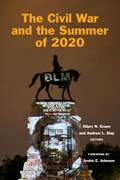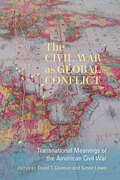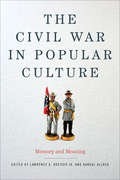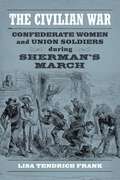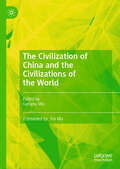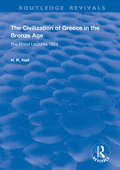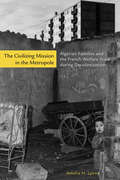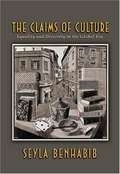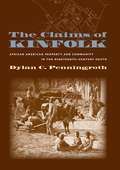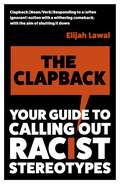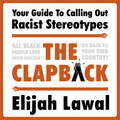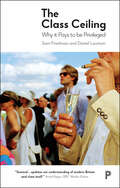- Table View
- List View
The Civil Rights Movement
by Peter V. LevyA clear picture of the movement, including biographies of major figures and copies of significant portions of documents.
The Civil Rights Movement (Revised Edition)
by Bruce J. DierenfieldA detailed account of the history of the civil rights movement, where blood of hundreds of thousands of people was shed fighting against the segregation for a right to vote and dignity.
The Civil Rights Movement and the Logic of Social Change
by Joseph E. LudersSocial movements have wrought dramatic changes upon American society. This observation necessarily raises the question: Why do some movements succeed in their endeavors while others fail? This book answers this question by introducing an analytical framework that begins with a shift in emphasis away from the characteristics of movements toward the targets of protests and affected bystanders, their interests, and why they respond as they do. Such a shift brings into focus how targets and other interests assess both their exposure to movement disruptions as well as the costs of conceding to movement demands. From this vantage point, diverse outcomes stem not only from a movement's capabilities for protest but also from differences among targets and others in their vulnerability to disruption and the substance of movement goals. Applied to the civil rights movement, this approach recasts conventional accounts of the movement's outcome in local struggles and national politics, and also clarifies the broader logic of social change.
The Civil Rights Movement in America (Chancellor Porter L. Fortune Symposium in Southern History Series)
by David Levering LewisWith essays and commentaries by David Levering Lewis, Clayborne Carson, Steven F. Lawson, Nancy J. Weiss, David J. Garrow, John Dittmer, Neil R. McMillen, Charles V. Hamilton, Mark V. Tushnet, William H. Chafe, and J. Mills Thornton III The Civil Rights Movement warrants continuing and extensive examination. The six papers in this collection, each supplemented by a follow-up assessment, contribute to a clearer perception of what caused and motivated the movement, of how it functioned, of the changes that occurred within it, and of its accomplishments and shortcomings. Its profound effect upon modern America has so greatly changed relations between the races that C. Vann Woodward has called it the “second revolution.” In a limited space, the eleven scholars range with a definitive view over a large subject. Their papers analyze and emphasize the Civil Rights Movement's important aspects: its origins and causes, its strategies and tactics for accomplishing black freedom, the creative tensions in its leadership, the politics of the movement in the key state of Mississippi, and the role of federal law and federal courts. In this collection a scholarly balance is achieved for each paper by a follow-up commentary from a significant authority. By deepening the understanding of the Civil Rights Movement, these essays underscore what has been gained through struggle, as well as acknowledging the goals that are yet to be attained.
The Civil Rights Movement in American Memory
by Leigh Raiford Renee Christine RomanoThe movement for civil rights in America peaked in the 1950s and 1960s; however, a closely related struggle, this time over the movement's legacy, has been heatedly engaged over the past two decades. How the civil rights movement is currently being remembered in American politics and culture--and why it matters--is the common theme of the thirteen essays in this unprecedented collection. Memories of the movement are being created and maintained--in ways and for purposes we sometimes only vaguely perceive--through memorials, art exhibits, community celebrations, and even street names. At least fifteen civil rights movement museums have opened since 1990; Mississippi Burning, Four Little Girls, and The Long Walk Home only begin to suggest the range of film and television dramatizations of pivotal events; corporations increasingly employ movement images to sell fast food, telephones, and more; and groups from Christian conservatives to gay rights activists have claimed the civil rights mantle. Contests over the movement's meaning are a crucial part of the continuing fight against racism and inequality. These writings look at how civil rights memories become established as fact through museum exhibits, street naming, and courtroom decisions; how our visual culture transmits the memory of the movement; how certain aspects of the movement have come to be ignored in its "official" narrative; and how other political struggles have appropriated the memory of the movement. Here is a book for anyone interested in how we collectively recall, claim, understand, and represent the past.
The Civil Rights Movement in Mississippi (Chancellor Porter L. Fortune Symposium in Southern History Series)
by Ted OwnbyContributions by Chris Myers Asch, Emilye Crosby, David Cunningham, Jelani Favors, Françoise N. Hamlin, Wesley Hogan, Robert Luckett, Carter Dalton Lyon, Byron D'Andra Orey, Ted Ownby, Joseph T. Reiff, Akinyele Umoja, and Michael Vinson WilliamsBased on new research and combining multiple scholarly approaches, these twelve essays tell new stories about the civil rights movement in the state most resistant to change. Wesley Hogan, Françoise N. Hamlin, and Michael Vinson Williams raise questions about how civil rights organizing took place. Three pairs of essays address African Americans' and whites' stories on education, religion, and the issues of violence. Jelani Favors and Robert Luckett analyze civil rights issues on the campuses of Jackson State University and the University of Mississippi. Carter Dalton Lyon and Joseph T. Reiff study people who confronted the question of how their religion related to their possible involvement in civil rights activism. By studying the Ku Klux Klan and the Deacons for Defense in Mississippi, David Cunningham and Akinyele Umoja ask who chose to use violence or to raise its possibility.The final three chapters describe some of the consequences and continuing questions raised by the civil rights movement. Byron D'Andra Orey analyzes the degree to which voting rights translated into political power for African American legislators. Chris Myers Asch studies a Freedom School that started in recent years in the Mississippi Delta. Emilye Crosby details the conflicting memories of Claiborne County residents and the parts of the civil rights movement they recall or ignore.As a group, the essays introduce numerous new characters and conundrums into civil rights scholarship, advance efforts to study African Americans and whites as interactive agents in the complex stories, and encourage historians to pull civil rights scholarship closer toward the present.
The Civil Sphere in Latin America
by Jeffrey C. Alexander Carlo TognatoSocial thinkers have criticized Latin American development as incomplete, backward, and anti-modern. This volume demonstrates that, while often deeply compromised and fragmented, Latin American civil spheres have remained resilient, institutionally and culturally, generating new oppositional movements, independent journalism, rebellious intellectuals, electoral power, and critical political parties. <P><P>In widely different arenas, dissidents have employed the coruscating language of the civil sphere to pollute their oppressors in the name of justice. In the 1970s and 1980s, political thinkers heralded the resurrection of Latin American civil society, envisioning a new world of freedom and stability. Corruption, inequality, racism, and exclusion become pressing and urgent 'social problems', not despite the promises of democracy, but because of them. The premise of this volume is that Latin American civil spheres are powerful, even as they are compromised, creating challenges to anti-civil culture and institutions that trigger social reform. It is the first of three volumes that place civil sphere theory in a global context.<P> Each empirical contribution employs, in innovative and deeply illuminating ways, civil sphere theory.<P> The chapters are written by professors who work almost exclusively in Latin American universities, experts in distinctive national and institutional domains.<P> Chapters address themselves to issues, strains, problems, and controversies of today's Latin America.
The Civil War and Pop Culture: Favorite Stories and Fresh Perspectives from the Historians of Emerging Civil War (Emerging Civil War Series)
by Chris Mackowski PhD; Jon TraceyExplore the enduring fascination of the Civil War through thought-provoking essays from the esteemed "Emerging Civil War" series to gain better understanding of the complex relationship between history and art in shaping our understanding of the war. The American Civil War left indelible marks on America’s imagination, collectively and as individuals. In the century and a half since the war, musicians have written songs, writers have crafted histories and literature, and filmmakers recreated scenes from the battlefield. Beyond popular media, the battle rages on during sporting events where Civil War-inspired mascots carry on old traditions. The war erupts on tabletops and computer screens as gamers fight the old fights. Elsewhere, men and women dress in uniforms and home-spun clothes to don the mantel of people long gone. Central to “history” is the idea of “story.” Civil War history remains full of stories. They inspire us, they inform us, they educate us, they entertain us. We all have our favorite books, movies, and songs. We all marvel at the spectacle of a reenactment—and flinch with startled delight when the cannons fire. But those stories can fool us, too. Entertainments can seduce us into forgetting the actual history in favor of a more romanticized version or whitewashed memory. The Civil War and Pop Culture: Favorite Stories and Fresh Perspectives from the Historians at Emerging Civil War explores some of the ways people have imagined and re-imaged the war, at the tension between history and art, and how those visions have left lasting marks on American culture. This collection of essays brings together the best scholarship from Emerging Civil War’s blog, symposia, and podcast—all of it revised and updated—coupled with original piece, designed to shed new light and insight on some of the most entertaining, nostalgic, and evocative connections we have to the war.
The Civil War and Reconstruction in Indian Territory
by Bradley R. ClampittIn Indian Territory the Civil War is a story best told through shades of gray rather than black and white or heroes and villains. Since neutrality appeared virtually impossible, the vast majority of territory residents chose a side, doing so for myriad reasons and not necessarily out of affection for either the Union or the Confederacy. Indigenous residents found themselves fighting to protect their unusual dual status as communities distinct from the American citizenry yet legal wards of the federal government. The Civil War and Reconstruction in Indian Territory is a nuanced and authoritative examination of the layers of conflicts both on and off the Civil War battlefield. It examines the military front and the home front; the experiences of the Five Nations and those of the agency tribes in the western portion of the territory; the severe conflicts between Native Americans and the federal government and between Indian nations and their former slaves during and beyond the Reconstruction years; and the concept of memory as viewed through the lenses of Native American oral traditions and the modern evolution of public history. These carefully crafted essays by leading scholars such as Amanda Cobb-Greetham, Clarissa Confer, Richard B. McCaslin, Linda W. Reese, and F. Todd Smith will help teachers and students better understand the Civil War, Native American history, and Oklahoma history.
The Civil War and the Press
by S. Kitrell RushingThe power of the American press to influence and even set the political agenda is commonly associated with the rise of such press barons as Joseph Pulitzer and William Randolph Hearst at the turn of the century. The latter even took credit for instigating the Spanish-American War. Their power, however, had deeper roots in the journalistic culture of the nineteenth century, particularly in the social and political conflicts that climaxed with the Civil War. Until now historians have paid little attention to the role of the press in defining and disseminating the conflicting views of the North and the South in the decades leading up to the Civil War. In The Civil War and the Press historians, political scientists, and scholars of journalism measure the influence of the press, explore its diversity, and profile the prominent editors and publishers of the day.The book is divided into three sections covering the role of the press in the prewar years, throughout the conflict itself, and during the Reconstruction period. Part 1, "Setting the Agenda for Secession and War," considers the rise of the consumer society and the journalistic readership, the changing nature of editorial standards and practice, the issues of abolitionism, secession, and armed resistence as reflected in Northern and Southern newspapers, the reporting on John Brown's Harper's Ferry raid, and the influence of journalism on the 1860 election results. Part 2, "In Time of War," includes discussions of journalistic images and ideas of womanhood in the context of war, the political orientation of the Jewish press, the rise of illustrated periodicals, and issues of censorship and opposition journalism. The chapters in Part 3, "Reconstructing a Nation," detail the infiltration of the former Confederacy by hundreds of federally subsidized Republican newspapers, editorial reactions to the developing issue of voting rights for freed slaves, and the journalistic mythologization of Jesse James as a resister of Reconstruction laws and conquering Unionists.In tracing the confluence of journalism and politics from its source, this groundbreaking volume opens a wide variety of perspectives on a crucial period in American history while raising questions that remain pertainent to contemporary tensions between press power and government power. The Civil War and the Press will be essential reading for historians, media studies specialists, political scientists, and readers interested in the Civil War period.
The Civil War and the Summer of 2020 (Reconstructing America)
by Hilary N. Green, Andrew L. SlapInvestigates how Americans have remembered violence and resistance since the Civil War, including Confederate monuments, historical markers, college classrooms, and history books.George Floyd’s murder in the summer of 2020 sparked a national reckoning for the United States that had been 400 years in the making. Millions of Americans took to the streets to protest both the murder and the centuries of systemic racism that already existed among European colonists but transformed with the arrival of the first enslaved African Americans in 1619. The violence needed to enforce that systemic racism for all those years, from the slave driver’s whip to state-sponsored police brutality, attracted the immediate attention of the protesters. The resistance of the protesters echoed generations of African Americans’ resisting the violence and oppression of white supremacy. Their opposition to violence soon spread to other aspects of systemic racism, including a cultural hegemony built on and reinforcing white supremacy. At the heart of this white supremacist culture is the memory of the Civil War era, when in 1861 8 million white Americans revolted against their country to try to safeguard the enslavement of 4 million African Americans.The volume has three interconnected sections that build on one another. The first section, “Violence,” explores systemic racism in the Civil War era and now with essays on slavery, policing, and slave patrols. The second section, titled “Resistance,” shows how African Americans resisted violence for the past two centuries, with essays discussing matters including self-emancipation and African American soldiers. The final section, “Memory,” investigates how Americans have remembered this violence and resistance since the Civil War, including Confederate monuments and historical markers.This volume is intended for nonhistorians interested in showing the intertwined and longstanding connections between systemic racism, violence, resistance, and the memory of the Civil War era in the United States that finally exploded in the summer of 2020.
The Civil War as Global Conflict: Transnational Meanings of the American Civil War (Carolina Lowcountry and the Atlantic World)
by David T. Gleeson and Simon LewisA collection of scholarly essays exploring the American Civil War from international perspectives.In an attempt to counter the insular narratives of much of the sesquicentennial commemorations of the Civil War in the United States, editors David T. Gleeson and Simon Lewis present this collection of essays that examine the war as more than a North American conflict, one with transnational concerns. The book, while addressing the origins of the Civil War, places the struggle over slavery and sovereignty in the United States in the context of other conflicts in the Western hemisphere. Additionally, Gleeson and Lewis offer an analysis of the impact of the war and its results overseas.Although the Civil War was the bloodiest conflict in US history and arguably its single most defining event, this work underscores the reality that the war was by no means the only conflict that ensnared the global imperial powers in the mid-nineteenth century. In some ways the Civil War was just another part of contemporary conflicts over the definitions of liberty, democracy, and nationhood.The editors have successfully linked numerous provocative themes and convergences of time and space to make the work both coherent and cogent. Subjects include such disparate topics as Florence Nightingale, Gone with the Wind, war crimes and racial violence, and choices of allegiance made by immigrants to the United States. While we now take for granted the nation’s values of freedom and democracy, we cannot understand the impact of the Civil War and the victorious “new birth of freedom” without thinking globally.The contributors to The Civil War as Global Conflict reveal that Civil War-era attitudes toward citizenship and democracy were far from fixed or stable. Race, ethnicity, nationhood, and slavery were subjects of fierce controversy. Examining the Civil War in a global context requires us to see the conflict as a seminal event in the continuous struggles of people to achieve liberty and fulfill the potential of human freedom. The book concludes with a coda that reconnects the global with the local and provides ways for Americans to discuss the war and its legacy more productively.Contributors: O. Vernon Burton; Edmund L. Drago; Hugh Dubrulle; Niels Eichhorn; W. Eric Emerson; Amanda Foreman; David T. Gleeson; Matthew Karp; Simon Lewis; Aaron W. Marrs; Lesley Marx; Joseph McGill; James M. McPherson; Alexander Noonan; Theodore N. Rosengarten; Edward B. Rugemer; Jane E. Schultz; Aaron Sheehan-Dean; Christopher Wilkins“The writers of this collection effectively balance local and global contexts to produce a significant text that is invaluable to any scholar interested in research desiring to move away from ‘pantomime-like North-South, black-white, blue-gray binaries.’” —Jesse Tyler Lobbs, Kansas State University
The Civil War in Popular Culture: Memory and Meaning
by Randal Allred“An important read for anyone trying to sort through the current social and political controversy over the question of how do we memorialize the Civil War.” —Strategy PageDividing the nation for four years, the American Civil War resulted in 750,000 casualties and forever changed the country’s destiny. The conflict continues to resonate in our collective memory, and U.S. economic, cultural, and social structures still suffer the aftershocks of the nation’s largest and most devastating war. Over a century and a half later, portrayals of the war in books, songs, cinema, and other cultural media continue to draw widespread attention and controversy.In The Civil War in Popular Culture: Memory and Meaning, editors Lawrence A. Kreiser Jr. and Randal Allred analyze American depictions of the war across a variety of mediums, from books and film to monuments and battlefield reunions to reenactments and board games. This collection examines how battle strategies, famous generals, and the nuances of Civil War politics translate into contemporary popular culture. This unique analysis assesses the intersection of the Civil War and popular culture by recognizing how memories and commemorations of the war have changed since it ended in 1865.
The Civilian War: Confederate Women and Union Soldiers during Sherman's March (Conflicting Worlds: New Dimensions of the American Civil War)
by Lisa Tendrich FrankThe Civilian War explores home front encounters between elite Confederate women and Union soldiers during Sherman's March, a campaign that put women at the center of a Union army operation for the first time. Ordered to crush the morale as well as the military infrastructure of the Confederacy, Sherman and his army increasingly targeted wealthy civilians in their progress through Georgia and the Carolinas. To drive home the full extent of northern domination over the South, Sherman's soldiers besieged the female domain-going into bedrooms and parlors, seizing correspondence and personal treasures-with the aim of insulting and humiliating upper-class southern women. These efforts blurred the distinction between home front and warfront, creating confrontations in the domestic sphere as a part of the war itself. Historian Lisa Tendrich Frank argues that ideas about women and their roles in war shaped the expectations of both Union soldiers and Confederate civilians. Sherman recognized that slaveholding Confederate women played a vital part in sustaining the Rebel efforts, and accordingly he treated them as wartime opponents, targeting their markers of respectability and privilege. Although Sherman intended his efforts to demoralize the civilian population, Frank suggests that his strategies frequently had the opposite effect. Confederate women accepted the plunder of food and munitions as an inevitable part of the conflict, but they considered Union invasion of their private spaces an unforgivable and unreasonable transgression. These intrusions strengthened the resolve of many southern women to continue the fight against the Union and its most despised general. Seamlessly merging gender studies and military history, The Civilian War illuminates the distinction between the damage inflicted on the battlefield and the offenses that occurred in the domestic realm during the Civil War. Ultimately, Frank's research demonstrates why many women in the Lower South remained steadfastly committed to the Confederate cause even when their prospects seemed most dim.
The Civilization of China and the Civilizations of the World
by Genyou WuThis book talks about “Human Spirit and its Manifestations: A ‘Civilizational’ Perspective”, “Image and Expectations: China from the Perspective of the ‘Other’ Lecture Series”, “Civilization Communication and Mutual Enrichment”, and “Civilizational Problems: A Cavalier Perspective”. Civilization is a kind of spiritual achievements with a holistic feature that is structural but not easy to see thoroughly in culture. This determines that “dialogue among civilizations” is not only a continuous and holistic cultural exchange activity, but also a material and spiritual exchange activity in different fields. With the growth of international peace power represented by China, the cultural exchanges and mutual learning activities among all ethnic groups in the world will be further promoted at a new height and breadth. The academic research on “dialogue among civilizations” followed in this book will also contribute to the arrival of this era. This book is suitable for general readers and scholars who are interested in Chinese culture, Chinese civilization, cultural exchanges, and mutual enrichment.
The Civilization of Greece in the Bronze Age: The Rhind Lectures 1923 (Routledge Revivals)
by H.R. HallFirst published in 1928, this volume contains six sequential lectures delivered by H.R. Hall in 1923 detailing the archaeological remains of Bronze Age Greece. Hall was keeper of Egyptian and Assyrian antiquities in the British Museum and author of ‘The Ancient History of the Near East’. Each of the author’s lectures was strictly chronological, with the main feature of each period being described in order. The profuse illustrations recreated here were fundamental to his view, with each Age defined through its art, pottery and stone carvings. These printed lectures follow their spoken counterparts closely and are brought to life with 320 illustrations inserted in places which reflect the original performances.
The Civilizing Mission in the Metropole: Algerian Families and the French Welfare State during Decolonization
by Amelia H. LyonsFrance, which has the largest Muslim minority community in Europe, has been in the news in recent years because of perceptions that Muslims have not integrated into French society. The Civilizing Mission in the Metropole explores the roots of these debates through an examination of the history of social welfare programs for Algerian migrants from the end of World War II until Algeria gained independence in 1962. After its colonization in 1830, Algeria fought a bloody war of decolonization against France, as France desperately fought to maintain control over its most prized imperial possession. In the midst of this violence, some 350,000 Algerians settled in France. This study examines the complex and often-contradictory goals of a welfare network that sought to provide services and monitor Algerian migrants' activities. Lyons particularly highlights family settlement and the central place Algerian women held in French efforts to transform the settled community. Lyons questions myths about Algerian immigration history and exposes numerous paradoxes surrounding the fraught relationship between France and Algeria—many of which echo in French debates about Muslims today.
The Claddagh Ring
by Malachy MccourtIrish tales of the ring worn by many of the Irish, many of which were found at Ground Zero.
The Claims of Culture: Equality and Diversity in the Global Era
by Seyla BenhabibHow can liberal democracy best be realized in a world fraught with conflicting new forms of identity politics and intensifying conflicts over culture? This book brings unparalleled clarity to the contemporary debate over this question. Maintaining that cultures are themselves torn by conflicts about their own boundaries, Seyla Benhabib challenges the assumption shared by many theorists and activists that cultures are clearly defined wholes. She argues that much debate--including that of "strong" multiculturalism, which sees cultures as distinct pieces of a mosaic--is dominated by this faulty belief, one with grave consequences for how we think injustices among groups should be redressed and human diversity achieved. Benhabib masterfully presents an alternative approach, developing an understanding of cultures as continually creating, re-creating, and renegotiating the imagined boundaries between "us" and "them." Drawing on contemporary cultural politics from Western Europe, Canada, and the United States, Benhabib develops a double-track model of deliberative democracy that permits maximum cultural contestation within the official public sphere as well as in and through social movements and the institutions of civil society. Agreeing with political liberals that constitutional and legal universalism should be preserved at the level of polity, she nonetheless contends that such a model is necessary to resolve multicultural conflicts. Analyzing in detail the transformation of citizenship practices in European Union countries, Benhabib concludes that flexible citizenship, certain kinds of legal pluralism and models of institutional powersharing are quite compatible with deliberative democracy, as long as they are in accord with egalitarian reciprocity, voluntary self-ascription, and freedom of exit and association. The Claims of Culture offers invaluable insight to all those, whether students or scholars, lawyers or policymakers, who strive to bridge the gap between the theory and practice of cultural politics in the twenty-first century.
The Claims of Kinfolk
by Dylan C. PenningrothIn The Claims of Kinfolk, Dylan Penningroth uncovers an extensive informal economy of property ownership among slaves and sheds new light on African American family and community life from the heyday of plantation slavery to the "freedom generation" of the 1870s. By focusing on relationships among blacks, as well as on the more familiar struggles between the races, Penningroth exposes a dynamic process of community and family definition. He also includes a comparative analysis of slavery and slave property ownership along the Gold Coast in West Africa, revealing significant differences between the African and American contexts.Property ownership was widespread among slaves across the antebellum South, as slaves seized the small opportunities for ownership permitted by their masters. While there was no legal framework to protect or even recognize slaves' property rights, an informal system of acknowledgment recognized by both blacks and whites enabled slaves to mark the boundaries of possession. In turn, property ownership--and the negotiations it entailed--influenced and shaped kinship and community ties. Enriching common notions of slave life, Penningroth reveals how property ownership engendered conflict as well as solidarity within black families and communities. Moreover, he demonstrates that property had less to do with individual legal rights than with constantly negotiated, extralegal social ties.
The Clamorgans: One Family's History of Race in America
by Julie WinchThe Damning, Absurd, and Revelatory History of Race in America Told through the History of a Single FamilyHistorian Julie Winch uses her sweeping, multigenerational history of the unforgettable Clamorgans to chronicle how one family navigated race in America from the 1780s through the 1950s. What she discovers overturns decades of received academic wisdom. Far from an impermeable wall fixed by whites, race opened up a moral gray zone that enterprising blacks manipulated to whatever advantage they could obtain. The Clamorgan clan traces to the family patriarch Jacques Clamorgan, a French adventurer of questionable ethics who bought up, or at least claimed to have bought up, huge tracts of land around St. Louis. On his death, he bequeathed his holdings to his mixed-race, illegitimate heirs, setting off nearly two centuries of litigation. The result is a window on a remarkable family that by the early twentieth century variously claimed to be black, Creole, French, Spanish, Brazilian, Jewish, and white. The Clamorgans is a remarkable counterpoint to the central claim of whiteness studies, namely that race as a social construct was manipulated by whites to justify discrimination. Winch finds in the Clamorgans generations upon generations of men and women who studiously negotiated the very fluid notion of race to further their own interests. Winch's remarkable achievement is to capture in the vivid lives of this unforgettable family the degree to which race was open to manipulation by Americans on both sides of the racial divide.
The Clapback: Your Guide to Calling out Racist Stereotypes
by Elijah LawalClapback: [Noun / Verb] Responding to a (often ignorant) notion with a withering comeback; with the aim of shutting. it. down.___________In order to have an honest and open conversation about race, we need to identify areas where things are not right. The Clapback: Your Guide to Calling Out Racist Stereotypes examines the evolution of the negative stereotypes towards the black community and arms you with the tools to shut them down once and for all. Taking readers on a journey through history, and providing facts and detailed research, this is an eye-opening and refreshing look at race and language. With a light-hearted, razor sharp wit and a refreshing honesty, The Clapback is the handbook the world needs - dishing out the hard truths and providing a road map for bringing some 'act right' into our everyday lives.It's time to Clapback.
The Clapback: Your Guide to Calling out Racist Stereotypes
by Elijah LawalA definitive guide to calling out racial stereotypes and understanding the meaning behind them___________Clapback: [Noun / Verb] Responding to a (often ignorant) notion with a withering comeback; with the aim of shutting. it. down.___________In order to have an honest and open conversation about race, we need to identify areas where things are not right. The Clapback: How to Call Out Harmful Black Stereotypes examines the evolution of the negative stereotypes towards the black community and arms you with the tools to shut them down once and for all. Taking readers on a journey through history, and providing facts and detailed research, this is an eye-opening and refreshing look at race and language. With a light-hearted, razor sharp wit and a refreshing honesty, The Clapback is the handbook the world needs - dishing out the hard truths and providing a road map for bringing some 'act right' into our everyday lives.It's time to Clapback.(p)2019 Hodder & Stoughton Limited
The Class Ceiling: Why it Pays to be Privileged
by Sam Friedman Daniel LaurisonPoliticians continually tell us that anyone can get ahead. But is that really true? This important book takes readers behind the closed doors of elite employers to reveal how class affects who gets to the top. Friedman and Laurison show that a powerful ‘class pay gap’ exists in Britain’s elite occupations. Even when those from working-class backgrounds make it into prestigious jobs, they earn, on average, 16% less than colleagues from privileged backgrounds. But why is this the case? . Drawing on 200 interviews across four case studies - television, accountancy, architecture, and acting – they explore the complex barriers facing the upwardly mobile. This is a rich, ambitious book that demands we take seriously not just the glass but also the class ceiling.
